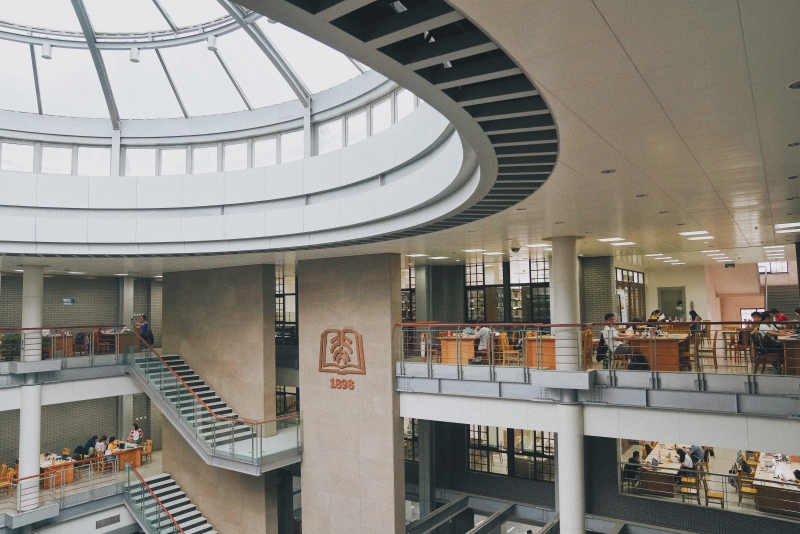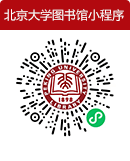Peking University, May 28, 2019: A short five-minute stroll away from the East gate of Peking University, Peking University Library stands out amongst the other landmarks in the vicinity with its floor area as large as 85,000 square meters. Nonetheless, beneath its majestic appearance, it is impossible to overlook the hundreds of years it has taken to develop into what it is today. With a capacity to store 8 million books and nearly 5000 seats, it is the largest library with the highest number of book collections across Asia.

How PKU Library comes to be as we know it today
The library dates back to 1898, where it was originally a book collection building for the Imperial University of Peking. On behalf of the government, influential scholar Liang Qichao (梁启超) sketched The Principles of the Imperial University of Peking. In these principles, he proposed: "The book collection building is established to gather important books from home and abroad, for the benefit of all kinds of readers and for a broad display of the ways and spirit of the world." Rules and regulations were made, duties and responsibilities of the staff members were clarified and a system for checking in and out was implemented for the library. These measures undertaken by Peking University Library in the early years are regarded as pioneering acts in transforming the library into one with exemplary management and organization.
Before the establishment of the East and West building of Peking University Library, the library was handicapped by its limited storage space. Books were stored in many different areas, making it a difficult task for students and teachers to locate and check them out. In 1975, the west building of the library was built, which is now known as the ”old library”. The west building had a floor area of 24,000 square meters and 2,400 seats, it was considered a symbol of recovery following after the Ccultural Rrevolution. In 1998, the new east building of the library was built thanks to the generous donations from Hong Kong industrialist Li Ka-shing (李嘉诚). This new building was connected to the old one, increasing the library’s floor area to 53,000 square meters. Modern designs and network technologies were incorporated, giving the library an entirely new look.
When you walk into the library today, the first thing that stands out is its facial verification system. Its purpose is to save students from the hassle of swiping their student cards every time they enter into the library.
Inside, the library has different departments such as the resource development centre, learning support centre, the Chinese rare books library, etc. that offer different services to cater the needs of the students. The first floor of the library contains the ancient book collection, music centre, as well as a dissertation management service. On the second floor, you can gain access to the literature collections, social sciences and humanities collection, digital experience area and the Folklore and Folk Literature Centre. On the third floor, you have the Special Collections, Social Sciences and Humanities Collections, Chinese Periodical Collection (Pre-1949) and Taiwan Literature, Periodical Collections and Professor Su Bai's Collections. The fourth floor contains Hong Kong and Taiwan Periodicals and Newspapers, Reference Book Collections, as well as a variety of periodical collections.
Apart from the main library, PKU library also has many other small-scaled libraries dispersed among all the schools and departments, each collecting books that are in the keenest need of its students.
Those who greatly influence PKU Library
The library’s journey through different sites and its transformation throughout history has taken it very far. It is impossible to forget the influential people that have taken turns to closely witness Peking University Library’s evolution. Without them, the library would not be what it is today.
In 1918, Chairman Mao worked as a librarian at Peking University. Cleaning up the rooms and sorting out the books would be a daily routine for him. In return, he was given the special permission to listen to lectures by prominent professors that were held in the library. The library became the place where he would devote himself to studying domestic issues. Nowadays, in the middle of the library lies a statue of young Chairman Mao.
Cai Yuanpei advocated for scientific research and democracy and initiated the academic atmosphere of "freedom of thought, embrace of diversity" during his tenure at Peking University. He transformed Peking University into a welcoming environment for different voices and opinions. President Cai led and supported the construction of the library of Peking University, which transformed the library into a modern library serving teachers and students.
Another influential curator of Peking University library was China's first Marxist communicator, Li Dazhao. He was an important leader during the founding of the Communist Party of China. In 1917, Li Dazhao was appointed the director of the library. During his tenure, Li carried out a series of reforms, making the library an important base for spreading Marxism and advanced ideas. Under Li's leadership, Peking University’s library flourished into a leading and influential university library in China.
Li Dazhao, Zhang Shizhao, Yuan Tongli, Ma Heng, Yan Wenyu, Xiang Da and other famous scholars have made great contributions to the library. Cai Yuanpei, Jiang Menglin, Hu Shih and other former presidents have also fought for the development of the library. These alma maters and scholars have left profound imprints on the development track of the library, giving it its academic and spiritual soul. Today, the walls on the entrance of the library have portraits of them to commemorate their contributions.
PKU Library in progress: a hub of knowledge, culture and communication
Nowadays, Peking University Library is equipped with modern technology and facilities, bringing convenience and endless possibilities to its students.
The Inter-Library Loan Service provides students access to books that are not only owned by Peking University, but also by libraries worldwide. If the book they need is not available at Peking University, they can have it sent to them by the Inter-Library Loan Service.
The Inter-Library Loan Service provides students access to books that are not only owned by Peking University, but also by libraries worldwide. If the book they need is not available at Peking University, they can have it sent to them by the Inter-Library Loan Service.
In 2014, the library introduced 3D printers in order to expose students to higher levels of technology and equipments. The library offers free services for students to make their own 3D printed model. Needless to say, it also provides basic printing services.
In addition, students can also enjoy 3D movies and hi-fi music in the library. The third floor of the library has a special digital application experience area for readers to use the latest apple computers, e-books and other devices. Two reading booths located on the first floor of the library allow students to practice for oral presentations disturbance-free. These sound proof booths resemble mini KTV booths and are very appealing to the students.
Peking University library is home to China's most cultural and precious treasures. It has a total collection of 1.5 million volumes of Chinese ancient books, of which 200,000 are rare books, local chronicles, genealogies, maps and Dunhuang manuscripts. In addition, there are over 70,000 pieces of rubbings (made using one of the oldest techniques in printmaking).
The Peking University Library is a hub of knowledge, culture, and communication. Apart from its oceans of books and resources, PKU Library also holds all sorts of lectures, exhibitions and activities to engage more students into communication and thought exchange. For example, the one-hour lecture series provided by the staff of the library equip students with useful searching tools and skills to facilitate their academic research. The reading marathon is a salon organized by the library, providing an opportunity for students to share their reading experiences with other students and famed professors from different departments. Recently, the May Fourth Movement exhibition going on in the library displays precious photos and materials for students to have a vivid experience of the history of the event in 1919.
Peking University library is home to China's most cultural and precious treasures. It has a total collection of 1.5 million volumes of Chinese ancient books, of which 200,000 are rare books, local chronicles, genealogies, maps and Dunhuang manuscripts. In addition, there are over 70,000 pieces of rubbings (made using one of the oldest techniques in printmaking).
The Peking University Library is a hub of knowledge, culture, and communication. Apart from its oceans of books and resources, PKU Library also holds all sorts of lectures, exhibitions and activities to engage more students into communication and thought exchange. For example, the one-hour lecture series provided by the staff of the library equip students with useful searching tools and skills to facilitate their academic research. The reading marathon is a salon organized by the library, providing an opportunity for students to share their reading experiences with other students and famed professors from different departments. Recently, the May Fourth Movement exhibition going on in the library displays precious photos and materials for students to have a vivid experience of the history of the event in 1919.
The collection of books in the library has been rapidly expanding, facilities constantly being added and improved, new equipment and technology always up to date. Its vast resources in a range of disciplines have important reference value for the study of modern Chinese society, history, politics, education and many other fields. This has made the library an aged yet modern Chinese library, holding the reputation as one of the best managed and largest libraries in Asia.
https://www.lib.pku.edu.cn/portal/en/bggk/bgjs/guanzhangjiyu
Written by: June Tan Rui Min
Edited by: Yan Shengnan, Zhang Jiang
Written by: June Tan Rui Min
Edited by: Yan Shengnan, Zhang Jiang





